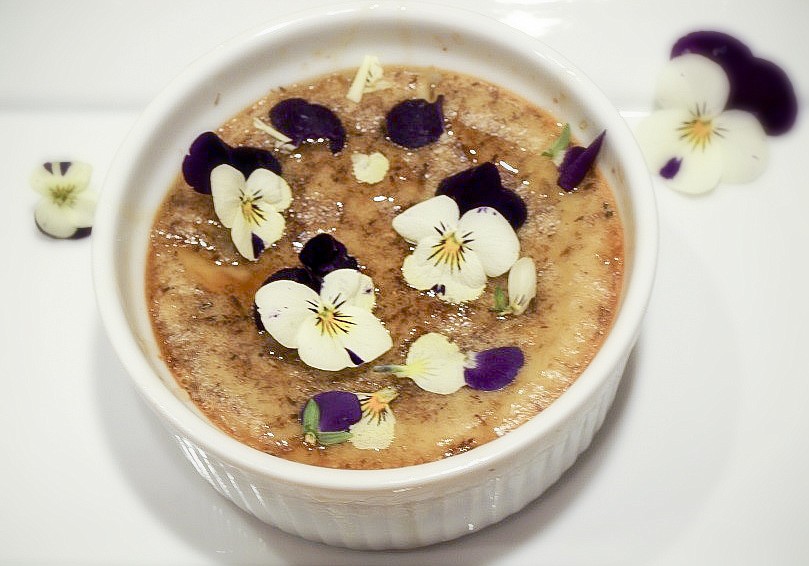Eat Your Flowers!
March 12, 2014 at 12:31 p.m.
Imagine a walk in a garden. Petals dapple the ground; a springtime aroma fills the air. In every direction, glorious whorls of velvety pink, gold, and violet catch the sunlight. Now imagine eating this garden: bright orange blossoms floating atop soup, burgundy petals sprinkled on cupcakes, a rainbow of tiny flowers brightening every salad bowl.
Guess what? This scene doesn’t have to be imaginary! Edible flowers can add an artistic touch to meals and are packed with the same health-giving nutrients found in colorful fruits and vegetables.
Consider planting an edible flower garden this spring. Raise food-grade flowers organically, free of chemicals that easily collect in the petals. Never buy flowers from the floral department for eating, and carefully label your garden: Not all flowers are edible!
Try fresh petals in salads or atop tea sandwiches, freeze whole flowers in ice cubes to create floating art. Flowers can flavor sauces or sweets or color vinegar. Each flower has a unique taste; here are five to try:
Viola (Viola tricolor)
Violas, or pansies, are pretty flowers of legend (called sweet violet, johnny-jump-up, heartsease, tickle my fancy, Jack-jump-up-and-kiss-me, come-and-cuddle-me, and love-in-idleness). Mild-tasting violas add color to salads, punches or sweets. Consuming just two violas fulfill a day’s requirement for vitamin C. Violas also contain beta-carotene, salicylates (found in aspirin), and the anti-inflammatory flavonoid rutin, believed to strengthen capillary walls. Perhaps the reason heartsease was traditionally used to heal a broken heart?
Nasturtium (Tropaeolum majus)
Easy-to-grow nasturtiums are brassicas, relatives of watercress and mustard, and have a distinct flavor; hence their name, which means “twisted nose” in Latin. They grow in a rainbow from fire-orange to cream, and are excellent in salads, pesto, risotto or pickled (seeds) like capers. Vitamin C-rich and once used to fight scurvy, Nasturtiums also contain the antioxidant pigments lycopene and lutein. Nasturtium’s mustard oils have antibiotic and respiratory decongestant activity, rationale for a traditional use in tea for bronchitis.
Lavender (Lavendula spp)
Bring the aroma of Provence (French call it “blue gold”) into your kitchen with fresh or dried lavender. Lavender tastes similar to rosemary in savory dishes like roasted potatoes, but it is also wonderful in sweets. Grinding lavender into salt or sugar releases essential oils that impart sophisticated flavor. Lavender contains iron and calcium and has medicinal uses as a sedative tea and treatment for insomnia, gas, nausea, nervousness and headache. Queen Elizabeth I even used lavender for her migraines!
Daylilies (Hemerocallis fulva)
Daylilly buds stir-fried in butter taste similar to asparagus; petals have a sweeter flavor and are classically used in hot and sour soup or deep fried (“golden needles”) in China. Daylilies (not to be confused with poisonous true lilies) contain protein and vitamin C, and up to 3,000 international units of beta-carotene per flower. Their orange hue harks from carotenoids zeaxanthin and lutein, which may reduce the risk of macular degeneration.
Calendula (Calendula officinalis)
This cheery gold and orange flower has a peppery taste that pairs well with cheese and pasta dishes. The dried petals can also be used as a saffron substitute or brewed in tea. Calendula has anti-inflammatory, antibacterial, and anti-viral properties, and is rich in carotenoids. Calendula is a member of the Asteraceae family, so use caution if you have pollen allergies.
Introduce all flowers in small amounts to test for allergies. To store flowers, wrap petals in moist paper towels and place in an airtight container in fridge. Rinse gently before using and remove stem and pistil with tweezers.
Try this floral spring recipe:
Lemon Lavender Custard with Viola Confetti
A dairy-free treat made with coconut milk and gently sweetened with honey. A pretty end to Mother’s Day brunch!
Ingredients:
2 eggs
1 15-ounce can coconut milk
Zest of 1 lemon
½ teaspoon dried lavender, ground in a coffee or spice grinder
1 ½ tablespoons honey
½ cup Viola tricolor flowers
Instructions:
Preheat oven to 350 degrees F. In a large bowl, beat eggs with an electric mixer until frothy, about 30 seconds. Stir in coconut milk, lemon zest, lavender and honey.
Divide mixture into four 4-ounce ramekins. Place ramekins in a glass baking dish and fill with hot water to reach halfway up the side of the ramekins. Bake 30 minutes, or until custard jiggles only slightly in center.
Remove ramekins from baking dish and cool in refrigerator at least 1 hour. To serve, drizzle with honey and top with whole and torn viola flowers.
Serves 4
Copyright 2014, A. Bermann, Original recipe
Reviewed by Cristen Harris, PhD, RDN and Cynthia Lair. Non-profit, accredited Bastyr University (bastyr.edu) offers multiple degrees in the natural health sciences, and clinical training at Bastyr Center for Natural Health (bastyrcenter.org), the region’s largest natural medicine clinic.





